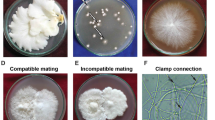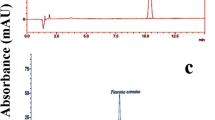Abstract
High production and good quality are always the principal goals for agriculturally important crops, without the exception of mushrooms. P. pulmonarius is one of the commercially important edible mushrooms throughout the world. The yield performance improvement was carried out by cross bred P. pulmonarius with P. sapidus and P. ostreatus. The highest rate of 0.587 mm/days for spawn ramification and 53.33 % for percentage spawn productivity were obtained in hybrids LN LL910. The least day (11 and 12th) of the primodia mushroom sporophore were recorded in LL910 and LN 97 respectively, while longest day of 19th was recorded in wild type (NE 07). The highest biological efficiency (109.30 %) and production rate (3.77 %) obtained by LL910, while the least of 33.0 and 0.79 % were obtained by NE 07 for biological efficiency and production rate respectively. The morphological and molecular characterization of the hybrid strains established their true variation from their wild type. LL 910 (JF68088) is located at seventh subclusters from the root with boostrap value of 32 %, while only one parent (LAU 09: JF736658) out of the two has the close boostrap value of 43 % at the first subcluster to the root, with the other parent LAU 10 (JF736659) shows distance relationship after Blast. LN 97 (JF680992) is located at outgroup, while the parent strains NE 07 (boostrap value: 11 %) and LAU 09 (boostrap value: 44 %) located at tenth and second subclusters respectively. The results obtained from this study have shown the improved performance of the hybrids strain over wild type strains.










Similar content being viewed by others
References
Bao D, Ishihara H, Mori N, Kitamoto Y (2004) Phylogenetic analysis of oyster mushrooms (pleurotus spp.) based on restriction fragment length polymorphisms of the 5′ portion of 26 s rDNA. J Wood Sci 50:169–176
Carlile MJ, Watkinson SC (1994) The fungi. Academic Press, New York, pp 9–76, 77–139, 153–172, 191–201
Eger G, Eden G, Wishing E (1976) Pleurotus ostreatus, breeding potential of a new cultivated mushroom. Theor Appl Genet 47:155–163
Felsenstein J (1989) PHYLIP-phylogeny inference package (version 3.2). Cladistic 5:164–166
Fritsche G (1983) Breeding Agaricus bisporus at the mushroom experimental station. Horst Mushroom J 122:49–53
Gardes M, Bruns TD (1993) ITS primers with enhanced specificity for basidiomycetes- application to the identification of mycorrhizea and rusts. Mol Ecol 2:113–118
Garzillo AMV, Di Paolog S, Kuzzi M, Buonocore V (1994) Hydrolytic properties of extracelluar cellulases from Pleurotus Ostreatus. Appl Microbiol 42:476–481
Isikhuemhen OS, LeBauer DS (2004) Growing Pleurotus tuberregium. In: Mushroom growers’ handbook 1, pp 264–274
Kibar B, Peksen A (2008) Modelling the effects of temperature and light intensity on the development and yield of different Pleurotus species. Agric Trop Subtrop 41(2):68–73
Kiguchi T, Yanagi SO (1985) Intraspecific heterokaryon and fruit body formation inCoprinus macrorhizus by protoplast fusion of auxotrophic mutants. Appl Microbiol Soc Jpn 28:217–228
Kuo M (2009) Pleurotus pulmonarius: The summer oyster. Mushroom Expert Com http://www.mushroomexpert.com/pleurotus_pulmonarius.html
Ma SM, Wang YF, Yi RH (2004) Review of edible fungi breeding. J. NW Sci Tech Univ Agric For 32:108–111
Marois H, Romas C, Matos N, Forgaes E, Cserhati T, Almeida V, Oliveira J, Darwish Y, Illes Z (2002) Liquid chromatographic and electrophoretic characterization of extracellular β-glucosidase of Pleurotus ostreatus grow in organic waste. J Chromatogr B770:111–119
Martin AM (1992) Study of the growth and biomass composition of the edible mushroom pleurotus ostreatus. Human Nutr 239–248
Membre JM, Kubaczka M, Chene C (1999) Combined effects of pH and sugar on growth rate of Zygosaccharomyces rouxii, a bakery product spoilage Yeast. Appl Environ Microbiol 65(11):4921–4925
Miles PG, Chang ST (1997) Mushroom biology: concise basics and current developments. World Scientific, Singapore, p 194
Obodai M, Cleland J, Vowotor KA (2003) Comparative study on the growth and yield of Pleurotus ostreatus mushroom on different lignocellulosic by- products. J Ind Microbiol Biotechnol 30:146–149
Oloke JK, Adebayo EA, Aina DA (2009) Effect of nitrogen and phosphate limitation on utilization of bitumen and production of bitu-oil and gas by a bacterial consortium. Afr J Biotechnol 8(24):6871–6879
Omoanghe S, Isikhuemhen OS, Mikiashvill NA (2009) Lignocellulolytic enzyme activity, substrate utilization, and mushroom yield by Pleurotus ostreatus cultivated on substrate containing anaerobic digester solids. J Ind Microbiol Biotechnol 36:1353–1362
Restaino L, Lobry JR, Bajard S, Flandrois JP (1983) Growth characteristics of Saccharomyces rouxii from chocolate syrup. Appl Environ Microbiol 45:1614–1621
Salmones D, Gaitan- Hernandez R, Perez R, Guzman G (1997) Estudios sobre el genero Pleurotus. Interaccion entre crecimiento micelial y productividad. Rev Iberoam Micol 14:173–176
Solomko EF, Eliseeva GS (1998) Biosynthesis of group B vitamins by the fungus pleurotus ostreatus in submerged culture. Prikl Biokhim 24(2):64–169
Toyomasu T, Mori K (1978) Intra- and interspecific protoplast fusion between some Pleurotus species. Agric Biol Chem 51:935–937
Vilgalys R, Hester M (1990) Rapid genetic identification and mapping of enzymatically amplified ribosomal DNA from several Cryptococcus species. J Bacteriol 172:4238–4246
Vilgalys R, Sun BL (1994) Ancient and recent patterns of geographic speciation in the Oyster mushroom pleurotus revealed by phylogenetic analysis of ribosomal DNA sequences. Proc Natl Acad Sci USA 91:4599–4603
Vilgalys R, Moncalvo JM, Liou SR, Volovcek M (1996) Recent advances in molecular systematics of the genus Pleurotus. In: Royse DJ (ed) Mushroom biology and mushroom products. PennState University, PennState, pp 91–102
Vogel F, Salmones D (2000) Analisis comparativo de la productividad de cepas de Pleurotus spp. cultivadas en una planta commercial. Rev Iberoam Micol 17:138–141
Wermer AR, Beelman RB (2002) Growing high-selenium edible and medicinal button mushrooms (Agaricus bisporus (J. Lge) Imbach) as ingredients for functional foods ordietary supplements. Int J Med Mushroom 4:167–171
Wisbeck E, Robert AP, Furlan SA (2002) Avalia Cao da produca de agents antimicrob lanos por fungos do genero Pleurotus. Health Environ J 3(2):07–10
Yin Y, Liu Y, Wang S, Li H, Niu L, Zhao S, Geng X, Li M, Xu F (2005) Cloning and characterization of the pyrG gene of Pleurotus ostreatus and Pleurotus eryngii. Afr J Microbiol Res 6(12):2869–2877
Yoo YB, Kong WS, Oh SJ, Jhune CS, Kim BG, Kim GH (1988) Gene transfer in edible mushrooms. Supplement 12:204–213
Zervakis G, Balis C (1996) Apluralistic approach in the study of Pleurotus species with emphasis on compatibility and physiology of the European morphotaxa. Mycol Res 100:717–731
Zervakis G, Philippoussis A, Ioannidou S, Diamantopoulou P (2001) Mycelium growth kinetics and optimal temperature conditions for the cultivation of edible Mushroom species on Lignocellulosic substrates. Folia Microbiol 46(3):231–234
Zhang YF, Molina FI (1995) Strain typing of Lentinula edodes by random amplified polymorphic DNA assay. FEMS Microbiol Lett 131:17–20
Acknowledgments
The Director of NEIST, India is gratefully acknowledged for granting facilities available to carry out this research, so also TWAS, Italy; and CSIR for the award of Postgraduate Fellowship given to me and utilized at NEIST, CSIR, Jorhat, India, and also to the authority of LAUTECH, Ogbomoso, Nigeria for granted the study leave to utilized the award.
Author information
Authors and Affiliations
Corresponding author
Rights and permissions
About this article
Cite this article
Adebayo, E.A., Oloke, J.K., Yadav, A. et al. Improving yield performance of Pleurotus pulmonarius through hyphal anastomosis fusion of dikaryons. World J Microbiol Biotechnol 29, 1029–1037 (2013). https://doi.org/10.1007/s11274-013-1266-8
Received:
Accepted:
Published:
Issue Date:
DOI: https://doi.org/10.1007/s11274-013-1266-8




